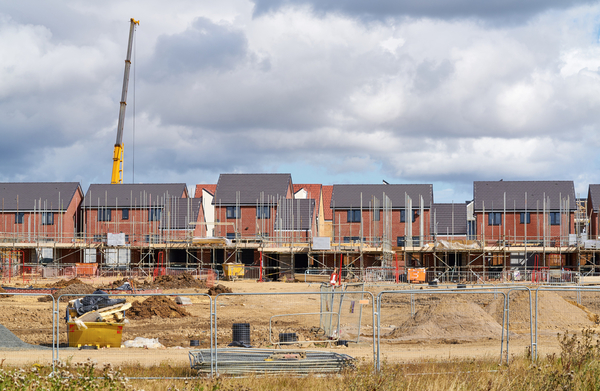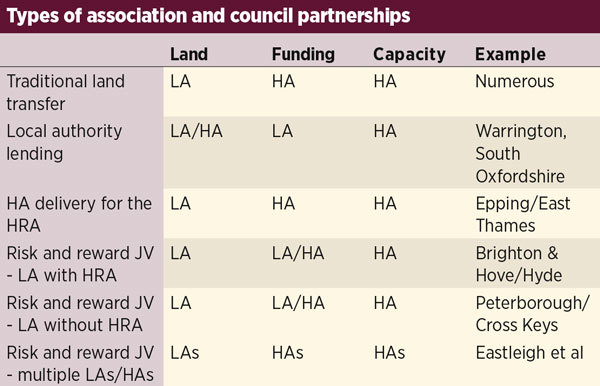Housing associations and councils: are we in a new age of partnership?
Funding models for shared ambitions

Steve Partridge is a director at Savills Housing Consultancy.
Steve is a senior leader and a highly regarded national ...READ MORE
Since the advent of self-financing for council housing in 2012, local authorities have explored a range of means of building homes.
In the main, the principal method development councils have settled on is subsidiary companies that are wholly owned by councils and acquire land and develop across the full range of housing types and tenures. The resulting raft of new local authority companies has in many ways been the story of the past few years, in terms of councils and boosting housing supply.
But this is not the only story. Housing associations and local authorities have also been collaborating in other ways to build more homes. In fact, great examples of collaborative working have been around for some time. Gradually but surely, and at some potential scale, we are seeing significant movement.
So what leading models are emerging, and what are the prospects for continued success and further increased housing supply?
First, it is useful to understand why housing companies were and continue to be attractive to local authorities.
They are partly a response to the shackles placed by the government almost immediately on self-financing Housing Revenue Accounts (HRAs). Their popularity is also in part due to growing austerity in wider council budgets, as subsidiary companies addressing the need for more housing, especially more affordable housing, give local authorities greater control over what is built and deliver a financial return along the way.
Traditional land transfer
This is one model, but collaboration with housing association partners is another approach that can offer impressive results – often greater than the sum of the parts (see table).
At its simplest, development requires three groups of resources: land, funding and delivery capacity (people with skills, expertise, a track record of delivery etc).
This process could be quite straightforward: a local authority has the land; a housing association has the finance and the people. It is a traditional model, but one which has left many councils feeling they have little stake in the future of the properties that result, except through nomination rights.
Local authority lending
Another approach has arisen since the financial crisis in 2007/08. Since then, some housing associations have struggled to access cheap, long-term development finance, whereas it can be relatively straightforward for councils to use their powers to lend to third parties, whether this is for development on their local authority land or not.
Some standout examples of this approach are: Warrington Borough Council, which on-lent more than £300m to at least 10 housing association partners; South Oxfordshire District Council lending £15m to its stock transfer landlord Soha; Adur and Worthing Councils lending £10m to Worthing Homes.
This is a straightforward win-win route to deliver financial return through interest payments to the council that exceed its own cost of funds, and resulting in more housing for the housing association and the local authority.
An alternative scenario that has presented itself since the advent of self-financing is to have money available in the HRA, but no capacity (people) to get homes built.
HA delivery for the HRA
Epping Forest District Council’s response to this conundrum was to let a full ‘development management’ contract to a local housing association, East Thames. The overview of the approach is that the council delivers land and funding, while the housing association delivers the programme for a fee.
Up to 200 homes have been built by Epping Forest in this way.
There are many other positive examples of collaboration between local authorities and housing associations. To date, this partnership working has not tended to require a new vehicle to make it possible. And that’s where the landscape might be changing.
Risk and reward joint ventures
Recently we have seen the announcement of the £106m, 50:50 joint venture between Hyde Group and Brighton & Hove City Council to build 1,000 homes – 500 each for rent and shared ownership.
From the outset the two parties will take an equal share of risks and rewards through the matching of land and investment funding into a new vehicle.
The local authority provides the land, and some development finance on-lent from the council in the established way, with the remainder of the funding coming from Hyde. Hyde also provides the people to run the programme.
The approach of setting up a new vehicle is not necessarily new. Councils and housing associations have been doing this for many years with developers and other partners (including in one case all three – council, association and developer at Sheffield Homes), but rarely with each other so directly.
Perhaps what particularly distinguishes the initiative in Brighton & Hove is the proposed ambition and commitment – 1,000 homes over 10 years as a minimum.
What is interesting is that there are partnerships being established that involve local authorities with an HRA (like Brighton & Hove) and also those councils that have transferred their housing stock and no longer have an HRA.
An example of where local authorities have struck up positive post-transfer delivery arrangements include Eastleigh and Fareham councils in a four-way joint venture with Vivid and Radian housing associations to build on council-owned land using the development expertise and financial clout of the two associations.
This is likely to continue. For instance, last summer a joint venture was announced between Peterborough City Council and Cross Keys Homes, with £20m of council funding to build a range of homes of all tenures. Other discussions are in progress.
The re-emergence of local authorities that have transferred their stock, as direct deliverers of housing, albeit in joint venture/partnership, could well be the next step in future collaborations.
The tale of different vehicles that deliver multiple tenures at scale and over time according to the capability of each partner to provide the blend of the deployment of land, funding and capacity, is a growing part of the trend towards diversification.
It also makes what might seem like an obvious point: local authorities and housing associations are the most natural of partners.
Previous policy environments, over many years, may have contributed to dislocation in some instances. But in responding to the twin challenges of austerity and the housing crisis, might we be on the threshold of a new age of partnership?
Steve Partridge is a director at Savills Housing Consultancy
RELATED





